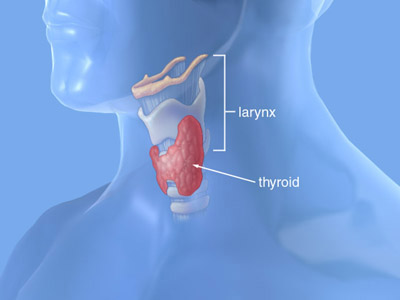 Thyroid hormones, involved in general growth of the body.
The thyroid gland is a main endocrine gland situated at the base of the neck, and is divided into two joined lobes. The thyroid produces and stores hormones which control the basal metabolic rate of the body, influence growth and maturation, and regulate blood calcium levels
Thyroid hormones, involved in general growth of the body.
The thyroid gland is a main endocrine gland situated at the base of the neck, and is divided into two joined lobes. The thyroid produces and stores hormones which control the basal metabolic rate of the body, influence growth and maturation, and regulate blood calcium levels The thyroid gland is a bilobed (butterfly – shaped) structure situated in front of the neck just below the larynx. The two lobes are joined by a narrow isthmus (interconnection). It secretes two hormones thyroxine and calcitonin. Thyroxine regulates the basal metabolism, i.e., the rate of cellular oxidation resulting in heat production at rest. An increase in the secretion increases metabolism and a decrease in secretion lowers it. It also influences the general growth of the body, ossification of bones, body temperature, mental development, etc. Calcitonin helps regulate calcium levels in our body and is involved in the process of bone building.
The thyroid gland produces two very similar hormones derived from the amino acid tyrosine: triiodothyronine(T3), which contains three iodine atoms, and tetraiodothyronine or thyroxine (T4), which contains four iodine atoms. The thyroid gland plays a crucial role in vertebrate development and maturation. Thyroid hormones help maintain normal blood pressure, heart rate, muscle tone, digestion and reproductive functions. Throughout the body, T3 and T4 are important in bioenergetics, generally increasing the rate of oxygen consumption and cellular metabolism. Too much or too little of these hormones in the blood can result in serious metabolic disorders. Hyperthyroidism, can lead to high body temperature, profuse sweating, weight loss, irritability and high blood pressure. Graves disease; protruding eyes, Hypothyroidism, the opposite condition, can cause cretinism in infants and produce symptoms such as weight gain, lethargy and intolerance to cold in adults. Goiter is caused due to iodine deficiency. Parathyroid glands are two small pairs of glands embedded in the back of the thyroid. Their hormone parathyroid hormone promotes movement of calcium ions from the bones to blood.